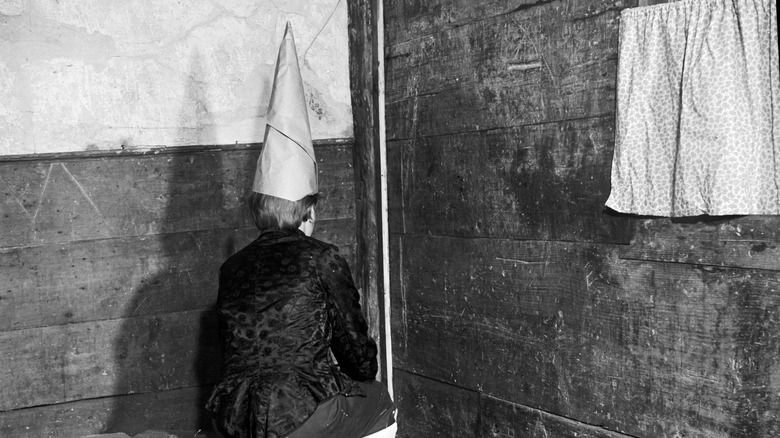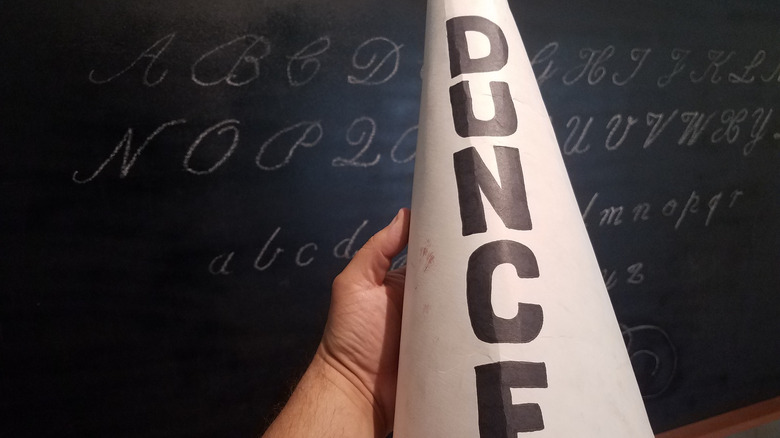The Dunce Cap Once Had An Unexpected Meaning
From the Victorian era to the middle of the 20th century, the dunce cap was placed upon the heads of American, French, and English schoolchildren who were causing disruptions or performing poorly in their studies (via Slate). Students wore the long pointy hat while standing or sitting on a stool. This was a form of humiliating punishment that also separated troublemakers from the rest of the class, as they were positioned in a corner apart from everyone else.
The public memory of this punishment is kept alive in movies, shows, and other forms of pop culture. In "Iron Man 3," for example, Tony Stark places a dunce cap on one of his disappointing robots (via TV Tropes). Missy Elliott wears one in the music video "Work It." Professor Farnsworth earns one in the "Futurama" episode "The Duh-Vinci Code." And of course, Calvin — from "Calvin and Hobbes" — donned the dunce cap more than once.
Yet the hat's meaning between the 1800s an today is wildly different from what it meant at its genesis, around the time the turn of the 14th century.
A Scotsman in France
In the late 13th century, the Scotsman John Duns Scotus was a theologian, philosopher, and educator in France. He grew famous for his brilliance and nuance, crafting arguments on free will, semantics and linguistics, the existence of God, cognition, and more (via the Internet Encyclopedia of Philosophy). One of his most prominent arguments defended the Immaculate Conception — the idea that the virgin Mary was born unaffected by the original sin of Adam, according to Britannica. As a priest, he focused heavily on matters of the divine.
Scotus soon had a following. His students were called "Dunsmen," and, according to Slate, they adorned tall pointy hats. Scotus and his disciples saw the caps as symbolizing wisdom and knowledge, as well as signaling allegiance to the new philosophy of Scotism. It has even been suggested Scotus thought the shape of the cap would somehow help funnel outside knowledge into the head (via All That's Interesting). That's right, the dunce cap was first a mark of high intelligence, the complete opposite of its modern connotation. So how did it undergo such a dramatic reversal?
From Brilliance to Ignorance
By the 16th century, Scotus was dead and so were many of his ideas. The Renaissance brought forth new modes of philosophical and theological thinking (via Slate). The medieval scholasticism of the Scotists, the reconciliation of Christian doctrine with philosophy, declined in importance while humanism — the focus on human concerns, natural explanations, and reason — came to the fore. Scotus' work was needlessly complex and far too focused on the supernatural. The Dunsmen were eventually viewed as misguided, old fashioned, even fools. The cap was mocked as a symbol of stupidity (perhaps this was aided by similarities to other fashions, such as the court jester's hat).
One cannot know who the last Dunsman was to wear the cap, but at some point over the next two centuries, the idea of a hat marking a fool made its way into classrooms, and the word "dunce" came from the name of Scotus' followers. As early as 1624, according to Slate, a "dunce-table" was featured in a play called "The Sun's Darling." Troublesome or underperforming students were placed at their own table in the classroom. We are unsure whether they were wearing hats, or if those came later.


